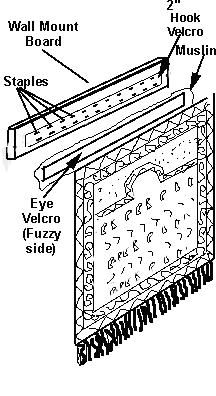Proper Wall Display of
Your Oriental Rug
First, what not to do:
![]() Don't display
your rug in direct sunlight, as UV rays will fade the vegetable dyes over time.
Use UV filters on spotlights or windows.
Don't display
your rug in direct sunlight, as UV rays will fade the vegetable dyes over time.
Use UV filters on spotlights or windows.
![]() Don't hang
your rug over a heater or vent, which will cause the fibers to become dry and
brittle. Also avoid hanging near humidifiers, which will lead to mildew.
Don't hang
your rug over a heater or vent, which will cause the fibers to become dry and
brittle. Also avoid hanging near humidifiers, which will lead to mildew.
![]() Don't hang
your rug in such a way that it comes in contact with any metal material such as
metal brackets, nails, staples, wire, etc. Over time, corrosion of the rug will
occur due to moisture in the air coming into contact with the metal.
Don't hang
your rug in such a way that it comes in contact with any metal material such as
metal brackets, nails, staples, wire, etc. Over time, corrosion of the rug will
occur due to moisture in the air coming into contact with the metal.
![]() Don't allow
your rug to come into contact with raw wood, the acidity of which can stain the
rug with corrosion. The area of the rug in contact with raw wood or metal should
be stitched with unbleached unstarched muslin (available at your local fabric
store), or the wood should be sealed with a urethane.
Don't allow
your rug to come into contact with raw wood, the acidity of which can stain the
rug with corrosion. The area of the rug in contact with raw wood or metal should
be stitched with unbleached unstarched muslin (available at your local fabric
store), or the wood should be sealed with a urethane.
![]() Never use
adhesives to display your rug.
Never use
adhesives to display your rug.
![]() Don't hang
silk rugs or weak rugs that cannot carry their own weight. Use a full-frame
mount.
Don't hang
silk rugs or weak rugs that cannot carry their own weight. Use a full-frame
mount.
VELCRO MOUNTING:
A popular modern method among collectors and museums is the Velcro mount. Carpets and flat-weaves in good condition can be mounted for wall display using Velcro (fragile, weak rugs or fragments will require full support from frame mounting explained below). Two-inch wide Velcro will support the weight of a large and heavy carpet. If displaying a pile rug, the pile should lay downward toward the floor, if the aesthetic design makes it possible. This also enhances lighting effects, as the angle of the pile in direction of the weave reflects more light than the opposite side. It also allows the warp, which runs the length of the rug and is strongest, rather than the selvage, to take the weight of the rug.
The following Velcro mounting procedure should be repeated approximately every 2 feet vertically down a large, heavy rug, to provide more evenly distributed support. Or, it can be repeated along the sides and bottom of the rug.

FRAME MOUNTING:
Construct a frame the size of the rug. Materials for making a frame can be found at your hardware store or art supply store. Stretch unbleached muslin over the frame and staple it to the back. Stitch the rug to the muslin using cotton or linen thread that matches the rug. Use whipstitches with 1/2 inch spacing along the edges of the rug. Make one stitch approximately every 1 to 2 feet vertically across open areas in the middle of the rug, to provide additional support.